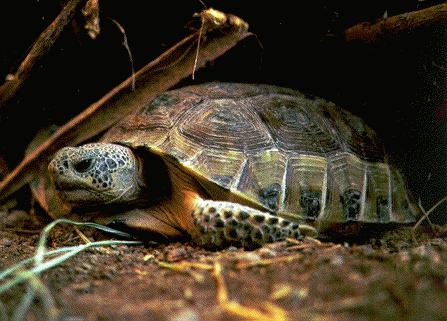for the Bolson Tortoise, Gopherus flavomarginatus,
in the Chihuahuan Desert

(Photo by David Morafka.)
GUSTAVO AGUIRRE,1 DAVID J. MORAFKA,2 and GARY A. ADEST 3
1 Instituto de Ecología, A. C., Km 2.5 Antigua Carretera a Coatepec,
Ap. Postal 63, 91000 Xalapa, Veracruz, Mexico / e-mail: aguirreg@ecologia.edu.mx
2 Department of Biology, California State University, Dominguez Hills, Carson, CA 90747-0005, USA
3 P.O. Box 2155, Camp Nelson, CA 93208, USA
ABSTRACT: Ecological studies of the Bolson tortoise, Gopherus flavomarginatus, were initiated by the Mexican Institute of Ecology in 1977 with the establishment of the MAB-UNESCO (Man and Biosphere - United Nations Educational, Scientific, and Cultural Organization) Mapimí Biosphere Reserve in the Chihuahuan Desert. The studies soon became a bi-national effort with the collaboration of U.S. researchers who developed a database and contributed to the formulation of conservation policies for the species.
The Bolson tortoise is endemic to the Mapimían subprovince of the Chihuahuan Desert. Its population decline and range contraction are a result of multiple factors, including climatic change and such increasing anthropogenic pressures as habitat modification and collection for food. During the last 15 years the Mapimí Reserve staff has developed a program to study and conserve this species, and significant knowledge of its biology has been accumulated. The program focused upon a wide array of topics to evaluate the status of the populations of this endangered reptile: the autocology of adult, juvenile, and neonatal classes; habitat use and spatial relationships; activity patterns; ecological distribution and tolerances; reproductive patterns and endocrinology; morphometry and sex dimorphism; diet and energetics; growth patterns; and thermal biology. Our primary concern has been the integration of these data into conservation, husbandry, and reintroduction programs.
Mapimí Reserve is successfully protecting tortoise populations within its boundaries. However, measures are needed to assure protection throughout the species’ range. The World Wildlife Fund-U.S. and the Turtle Recovery Program have supported research in the Sierra del Diablo District (Chihuahua State) where healthy populations, comparable to those of Mapimí, still remain. A joint U.S.-Mexican plan to reintroduce the Bolson tortoise into the Big Bend region of southwest Texas has been explored. Efforts are underway to link the three biosphere reserves